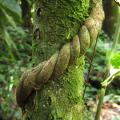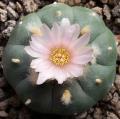
DMT-Nexus member
Posts: 1111 Joined: 18-Feb-2017 Last visit: 12-Jul-2024
|
That makes sense.
Two more questions:
1. When precipitating harmaline (during harmine-harmaline separation), I get two strong pH depressions - presumably one for the harmine and the other for the harmaline. But if I keep adding ammonia, more stuff precipitates. It has a lighter color and is fluffy and light (stays in suspension for a long time and an overnight is not enough for it to all settle). It's present in much smaller amounts than the darker colored, heavy harmaline, which settles very quickly. Is this stray, cleaner harmaline that the lower pH didn't push out, or some other alkaloid that the manske let through?
I've bioassayed 40mg of this late-precipitating freebase sublingually and it felt like a harmala alkaloid, but it wasn't super strong and I wouldn't know if it's harmaline, harmalol or any other of the bunch.
2. I'm reusing zinc from a previous reduction. There is some white powder in it (the first time it has happened; normally I dry my used zinc over mild heat, but this time I dried it over a cold fan, so maybe that's why). I'm assuming this white powder is zinc oxide. Is this metallic zinc mixed with a bit of zinc oxide safe to use? A google search reveals zinc oxide dissolves in HCl and NaOH, but I'm not sure about acetic acid and ammonia? Just in case, before starting the reduction I washed it with vinegar in the hope the vinegar would dissolve the zinc oxide and leave just the metallic zinc.
|
|
|
|
|

DMT-Nexus member
Posts: 562 Joined: 20-Nov-2009 Last visit: 07-Jan-2023
|
https://catbull.com/alam...in%20aya%20decoction.pdfhxxps://catbull.com/alamut/Bibliothek/various%20alkaloid%20profiles%20in%20aya%20decoction.pdf Theoretically and subjectively, looking at the serotonin reuptake properties of LSD & mescaline at approx 3.7 to 3.6 at 5-ht1a (80% of brain 5-ht) on a scale of 4.00 being max, ibogaine is quite similar at around 3.60 ...recall that DMT has zero activity at 5-ht1a according to two recent studies, this means dmt is possibly only stimulating 20% of brain 5-ht by itself unlike all the other natural oral entheogens or snuff's (LSD, mescaline, mushrooms, ibogaine, snuff's). It requires team work with caapi (activation of SERT thru THH) or snuff's (5-ht1a activation), or perhaps even harmalas to activate 5-ht1a. Caapi and snuff's are strong at SERT and 5-ht1a respectively, the harmalas perhaps a bit weaker, similar to mushrooms at 5-ht1a. ...if THH is anything like ibogaine (and they are both from the same betacarboline family), we might one day find that 100mg of THH to be similar to approx 100ug of Hoffman's elixir when it comes to the specific property of serotonin blockage reuptake strength or blockade of serotonin, otherwise known as anti-serotonin properties judging from the numbers above at 5-ht1a and SERT. THH additionaly agonizes all 3 adrenal receptors a2a, a2b, and a2c with great strength (similar to dmt), while mescaline does the same at a strong max at a2a and strong at a2c. LSD is strong at a2a only. 2011 Thomas S. Ray study: Breadth of Receptor Binding, 4.00=max, 0.00=min Quote:LSD: 5ht1a = 3.73, DMT: = 0.00, psilocin = 2.88, mescaline = 3.61, 5-meo-DMT: = 4.00, Ibogaine: 3.57 SERT Ibogaine has been shown to inhibit serotonin transporter (SERT) noncompetitively, in contrast to all other known inhibitors, which are competitive with substrate. (these serotonin filters/gates/barriers/doors make up >80% of brain 5-ht & are broken down when 5-ht1a is agonized) Thomas S. Ray, Psychedelics and the Human Receptorome (2010): hxxp://journals.plos.org/plosone/article?id=10.1371/journal.pone.0009019 Breadth of Receptor Binding, 4.00=max, 0.00=min Quote:LSD: 5ht1a = 3.73, DMT: = 0.00, psilocin = 2.88, mescaline = 3.61, 5-meo-DMT: = 4.00 (make up >80% of brain 5-ht)
LSD: 5ht1b = 4.00, DMT: = 0.00, psilocin = 2.19, mescaline = 0.00, 5-meo-DMT: = 2.41
LSD: 5ht1d = 3.70, DMT: = 3.91, psilocin = 3.40, mescaline = 0.00, 5-meo-DMT: = 3.48
LSD: 5ht1e = 2.62, DMT: = 3.28, psilocin = 3.03, mescaline = 3.16, 5-meo-DMT: = 1.72
LSD: 5ht2a = 3.54, DMT: = 2.58, psilocin = 2.14, mescaline = 0.00, 5-meo-DMT: = 0.98
LSD: 5ht2b = 3.11, DMT: = 3.91, psilocin = 4.00, mescaline = 3.97, 5-meo-DMT: = 0.69
LSD: 5ht2c = 3.11, DMT: = 3.42, psilocin = 2.52, mescaline = 0.00, 5-meo-DMT: = 1.55
LSD: 5ht5a = 3.64, DMT: = 3.16, psilocin = 2.83, mescaline = 0.00, 5-meo-DMT: = 1.84
LSD: -5ht6 = 3.75, DMT: = 3.35, psilocin = 2.82, mescaline = 0.00, 5-meo-DMT: = 2.73
LSD: -5ht7 = 3.77, DMT: = 4.00, psilocin = 2.82, mescaline = 0.00, 5-meo-DMT: = 3.69
LSD: ---D1 = 2.34, DMT: = 3.51, psilocin = 3.37, mescaline = 0.00, 5-meo-DMT: = 2.38
LSD: -A-2A = 2.93, DMT: = 2.75, psilocin = 1.36, mescaline = 2.92, 5-meo-DMT: = 0.00 (aesthetic/beauty adrenal a2a)
LSD: -A-2B = 0.00, DMT: = 3.53, psilocin = 1.57, mescaline = 0.00, 5-meo-DMT: = 0.86 (aesthetic/beauty adrenal a2b)
LSD: -A-2C = 0.00, DMT: = 3.53, psilocin = 1.03, mescaline = 4.00, 5-meo-DMT: = 1.57 (aesthetic/beauty adrenal a2c) The teamwork of all the alkaloids together are stronger than just one part, Caapi + leaf specifically for example is the whole sum of the experience as eliquently written by Shanon: Antipodes of the Mind, page 385: Quote:Significantly, what people feel when under the Ayahuasca intoxication is that she brings them in touch with the anima mundi or the Divine consciousness which is the Ground of all Being, the source of all knowledge, the fountain of all wisdom. In a direct, non-mediated fashion drinkers also feel that it is this consciousness that is the source of the visions and the insights associated with them. When the force of the inebriation is especially strong, drinkers feel that the boundaries between this consciousness and their own individual one are less and less defined. In the limit, I and God become one. All that can be known is part and parcel of the Divine mind, hence also my mind.
This cosmic account of the Ayahuasca experience is, of course, reminiscent of ideas that have been proposed in the mystical literature throughout the ages. It is in line with what has been called the perennial philosophy (see Huxley, 1944). You may remember me as 69Ron. I was suspended years ago for selling bunk products under false pretenses. I try to sneak back from time to time under different names, but unfortunately, the moderators of the DMT-Nexus are infinitely smarter than I am.
If you see me at the waterpark, please say hello. I'll be the delusional 50 something in the American flag Speedo, oiling up his monster guns while responding to imaginary requests for selfies from invisible teenage girls.
|
|
|

DMT-Nexus member
Posts: 71 Joined: 16-Dec-2017 Last visit: 08-Oct-2024
|
Jagube wrote:That makes sense.
Two more questions:
1. When precipitating harmaline (during harmine-harmaline separation), I get two strong pH depressions - presumably one for the harmine and the other for the harmaline. But if I keep adding ammonia, more stuff precipitates. It has a lighter color and is fluffy and light (stays in suspension for a long time and an overnight is not enough for it to all settle). It's present in much smaller amounts than the darker colored, heavy harmaline, which settles very quickly. Is this stray, cleaner harmaline that the lower pH didn't push out, or some other alkaloid that the manske let through?
I've bioassayed 40mg of this late-precipitating freebase sublingually and it felt like a harmala alkaloid, but it wasn't super strong and I wouldn't know if it's harmaline, harmalol or any other of the bunch.
2. I'm reusing zinc from a previous reduction. There is some white powder in it (the first time it has happened; normally I dry my used zinc over mild heat, but this time I dried it over a cold fan, so maybe that's why). I'm assuming this white powder is zinc oxide. Is this metallic zinc mixed with a bit of zinc oxide safe to use? A google search reveals zinc oxide dissolves in HCl and NaOH, but I'm not sure about acetic acid and ammonia? Just in case, before starting the reduction I washed it with vinegar in the hope the vinegar would dissolve the zinc oxide and leave just the metallic zinc. For #1 - I believe that "3rd alkaloid" was discussed somewhere in this long thread, and also described in one of the VDS experiments, but I don't know off the top of my head what they concluded about it, and I did not observe this personally. For #2, yes, highly likely its zinc oxide. If you are in the US you can get high purity, high quality, elemental zinc on ebay for quite cheap, and you don't need a lot for these reductions, so I would not bother trying to reuse the leftovers. Keep it tightly sealed and dry.
|
|
|

DMT-Nexus member
Posts: 212 Joined: 16-Oct-2016 Last visit: 10-Feb-2025
|
Concerning #1: the same thing was observed bij Jees earlier in this thread. It was even temporarily named 'Nexine'. Further microscopic research and Zn-reduction revealed it to be DHH. I think with proper stirring and slow addition of base, this fraction will precipitate out together with the bulk of the DHH...
|
|
|

DMT-Nexus member
Posts: 1104 Joined: 11-Feb-2017 Last visit: 18-Jan-2021
|
Today I tried pH separation again but again it failed.
I dissolved freebase alkaloids in warm/hot water (20 g/L) containing just enough acetic acid to dissolve everything.
I then added 10% ammonia using dropper and observing pH values with a probe.
To my surprise, precipitation started at pH 5.2 (!!) and the first pH drop occured at pH 6.4.
I tried separation on two batches, each resulting in differently colored fractions. The harmine fraction was once very dark and the other time much lighter.
The harmaline fraction was light, but still way darker than harmaline I have form some previous experiments.
It seems the separation is different every time and depends on some hidden factors like the amount of excess acid (used to dissolve the alkaloids), on the alkaloid concentration, water temperature and maybe more.
The alkaloid concentration does not seem to be as important as the acid concentration. When I used just enough acetic acid to dissolve everything (or when I started with harmala hydrochlorides straight away), the separation was very poor and the fractions were mixed.
However, when I used excess acid, like dissolving 15-20 g/L freebase harmalas in 7% acetic acid, the separation seemed much sharper, resulting in very dark harmine and very light harmaline.
|
|
|

DMT-Nexus member
Posts: 212 Joined: 16-Oct-2016 Last visit: 10-Feb-2025
|
Blue.magic, are you using a mechanical stirrer of some sort? It helps in getting reproducible results.
The color differences are normal. It seems there is a darker fraction that uses the nucleation points of other alkaloids to precipitate itself.
I suppose you also use a microscope to identify pure or mixed fraction?
Good luck, An1cca
|
|
|

DMT-Nexus member
Posts: 1104 Joined: 11-Feb-2017 Last visit: 18-Jan-2021
|
Yes I use magnetic stirrer to make a vortex, then add base to the center of the vortex so it quickly dissolves.
I think I am still adding too much (1-2 mL of 10% ammonia at a time) so somehow the vital pH separation point is missed. But adding less base makes the whole separation very laborious and time consuming.
I don't have a microscope unfortunately.
|
|
|

DMT-Nexus member
Posts: 4031 Joined: 28-Jun-2012 Last visit: 05-Mar-2024
|
blue.magic wrote:...I don't have a microscope unfortunately. Get one  I'm planning to make a thread how to get decent a view on harmala crystals using microscope. Something I don't get is how VDS crystallizes a mixed fraction under microscope and then he sees perfect harmine crystals next to perfect harmaline crystals, published in his paper. It's hard to get that result, on my end it makes a one mix-form of crystal shape, see attachment of unseparated syrian rue extract dissolved in vinegar to grow crystals on a drop of ammonia. Timescale is speed up X10 to X15. When the drops meet, instantaneously there forms a "milk" effect, which is to see as the brown sea of micro crystals (?) in the video and then these redissolve again to build up the real crystals as we know them. After that no milk is seen anymore, in this case it takes aprox 15 minutes. PS: why can't I upload mp4? This is a mp4 renamed as mov for upload sake, yet works on my system in playback no problem as is. If you have playback trouble just rename it as .mp4
|
|
|

DMT-Nexus member
Posts: 212 Joined: 16-Oct-2016 Last visit: 10-Feb-2025
|
That is just beautiful, Jees! Looking forward to a dedicated microscopy thread 
|
|
|

DMT-Nexus member
Posts: 212 Joined: 16-Oct-2016 Last visit: 10-Feb-2025
|
blue.magic wrote:I think I am still adding too much (1-2 mL of 10% ammonia at a time) so somehow the vital pH separation point is missed. But adding less base makes the whole separation very laborious and time consuming. Indeed, that might be a bit too much at a time. Having your pH-meter in your solution that is mechanically stirred, it will surely take less than 30 minutes to do a careful separation of the alkaloids. With time, you get a feel of the pH-depressions and the separation takes less than 10 minutes. If you 'surf the precipitation-waves', a microscope isn't that necessary. Although very beautiful...
|
|
|

DMT-Nexus member
Posts: 1111 Joined: 18-Feb-2017 Last visit: 12-Jul-2024
|
There was a mention somewhere that the zinc reduction produces a relatively low yield, like 80%.
I used to get low yields (60%), now I think that's because my reductions weren't complete, and I was discarding a lot of harmaline, which didn't all precipitate at my pH cut-off point of ~10.0.
And they weren't complete, because there wasn't enough acid.
Now I've learned to acidify it to pH between 2.0 - 2.5, first with vinegar (in triple excess as per the video), which brings it to the upper 3's or lower 4's, and then by mixing in a tiny bit of fuming HCl. I don't want to add too much HCl, as that would cause the harmaline to crash out as harmaline HCl. That's why I add vinegar first. When there is plenty of vinegar in solution and a bit of HCl, it won't crash out as it's less likely to form HCl salts, so the concentration of harmaline HCl is low enough to stay completely dissolved.
My last reduction had a yield of 91%.
|
|
|

DMT-Nexus member
Posts: 212 Joined: 16-Oct-2016 Last visit: 10-Feb-2025
|
Jagube, congratulations on your yield.
I reach the same yields with vinegar only.
Also, DHH.HCl will not precipitate out unless in a saturated NaCl solution, so no precautions or worries my friend....
|
|
|

DMT-Nexus member
Posts: 1111 Joined: 18-Feb-2017 Last visit: 12-Jul-2024
|
An1cca wrote:Also, DHH.HCl will not precipitate out unless in a saturated NaCl solution, so no precautions or worries my friend.... I've had it precipitate when I have added too much HCl. https://www.dmt-nexus.me...&m=938428#post938428
|
|
|

DMT-Nexus member
Posts: 212 Joined: 16-Oct-2016 Last visit: 10-Feb-2025
|
Right, too many Cl-ions...
With vinegar 7° you should be fine.
|
|
|

DMT-Nexus member
Posts: 71 Joined: 16-Dec-2017 Last visit: 08-Oct-2024
|
Jees wrote:When the drops meet, instantaneously there forms a "milk" effect, which is to see as the brown sea of micro crystals (?) in the video and then these redissolve again to build up the real crystals as we know them. After that no milk is seen anymore, in this case it takes aprox 15 minutes.
Great video, thanks for sharing. I've got a microscope camera as well, but have barely used it. One of these days...
|
|
|

DMT-Nexus member
Posts: 4031 Joined: 28-Jun-2012 Last visit: 05-Mar-2024
|
GordoTEK wrote:...Great video, thanks for sharing. I've got a microscope camera as well, but have barely used it. One of these days... TY Its fun watching down scale 
|
|
|

DMT-Nexus member
Posts: 1111 Joined: 18-Feb-2017 Last visit: 12-Jul-2024
|
I think there is some confusion about fluorescence.
Harmaline glows green. When I reduce harmaline with no significant harmine content, the fluorescence is lost, the resulting solution doesn't fluoresce at all.
I always thought that was because the blue fluorescence was supposed to be very faint, only noticeable at higher THH concentrations, and perhaps my cheap UV flashlight didn't have the best spectrum to show it.
However, I have recently conducted zinc reduction on harmine contaminated with harmaline. The goal was to get rid of the harmaline, which two ammonia separation steps had failed to do. It was glowing green before the reduction, but after the reduction it glowed a nice blue. It was the first time I saw blue fluorescence.
I'm wondering what's going on here? Harmine is supposed to be impervious to zinc reduction. Could it be some stray alkaloid other than harmine and harmaline that reduces to something that glows blue, and happens to co-precipitate with harmine, thereby co-occurring with it?
|
|
|

DMT-Nexus member
Posts: 1104 Joined: 11-Feb-2017 Last visit: 18-Jan-2021
|
I don't agree. IME the blue fluorescence of THH is actually stronger at low concentrations.
If I add a tiny drop of THH acetate in a beaker with water, it glows almost like a bottle of Tonic Water. However, the reduced reaction mixture, which I usually run at 15-20 g/L harmaline concentration, does not glow, only has a very deep blue hue.
|
|
|

DMT-Nexus member
Posts: 1111 Joined: 18-Feb-2017 Last visit: 12-Jul-2024
|
blue.magic wrote:I don't agree. IME the blue fluorescence of THH is actually stronger at low concentrations. Thanks, that actually makes sense and probably answers my question: When I reduce nearly pure harmaline, the concentration of the THH is high, so it doesn't glow. But when I reduced what was mostly harmine, with some harmaline contamination, the THH concentration was low and therefore it glowed blue.
|
|
|

DMT-Nexus member
Posts: 545 Joined: 02-Dec-2017 Last visit: 07-Jun-2025 Location: right side of the river
|
Hi guys, I am trying this conversion and have a question.
I mixed harmaline in vinegar with zinc powder and let it react in a jar with occasional stirring. Is production of small bubbles a sign of ongoing reaction? It is now 3 days from the start and bubbles are still there.
My harmaline is most likely mixed with some harmine, as I only separated harmine by sodbicarb and am only using basic pH strips, so no exact pH measurement.
|